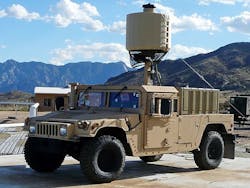Army asks SRCTec to build lightweight counter-mortar radar (LCMR) in $85 million order
ABERDEEN PROVING GROUND, Md., 13 July 2016. U.S. Army air-defense experts are asking engineers at SRCTec LLC in Syracuse, N.Y., to build lightweight counter-mortarradar (LCMR) systems to help defend deployed warfighters from rocket, artillery, and mortar (RAM) attacks.
Officials of the Army Contracting Command at Aberdeen Proving Ground, Md., announced a three-year potential $85 million contract modification to SRCTec on Tuesday for LCMR systems, as well as vehicle mounts, spare parts, retrofit kits, and support services.
The LCMR family of counter-fire radars from SRCTec provides 360-degree surveillance and 3D rocket, artillery, and mortar location using a non-rotating, electronically steered antenna.
The SRCTec LCMR family consists of the AN/TPQ-49 and AN/TPQ-50. The TPQ-50 is the official Army program of record, while the TPQ-49 is designed for expeditionary forces, company officials say.
The radar systems detect and track several different rounds fired from separate locations, and send early warning messages indicating a round is incoming. The radar also pinpoints the location of the incoming round's launcher for counter-fire from friendly artillery, mortars, or aircraft.
Both systems are designed to cover 360 degrees over a nearly 200-square-mile area. The systems can be adapted to cover narrower sectors at longer ranges, if necessary.
The LCMR AN/TPQ-50 system detects incoming RAM from low-quadrant elevations, and provides a more accurate point of origin calculation from greater distances than its predecessors. The radar can be transported and operated on a vehicle such as a HMMWV, or rapidly emplaced in rugged terrain by installing it on a tripod.
The LCMR AN/TPQ-49 radar can be assembled or disassembled by two soldiers in 20 minutes. It mounts on a tripod using lightweight antenna hardware. The relatively small system consumes low prime power, making it suitable for low-profile operation.
SRCTec originally won a potential $281.8 million contract in July 2013 to manufacture LCMR systems. On the contract modification announced Tuesday SRCTec will do the work at locations determined with each order, and should be finished by July 2019.
For more information contact SRCTec online at www.srcinc.com, or the Army Contracting Command-Aberdeen at http://acc.army.mil/contractingcenters/acc-apg.

